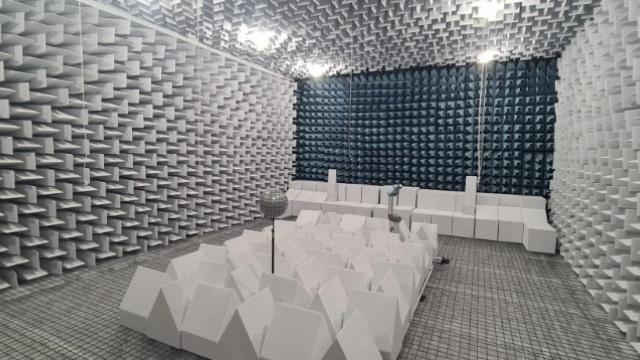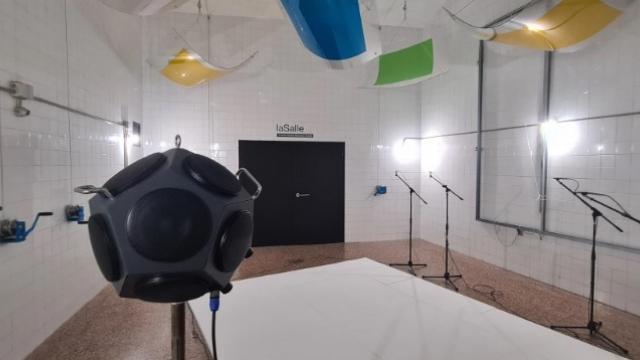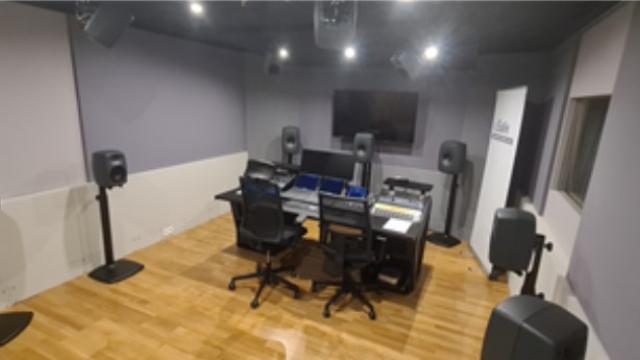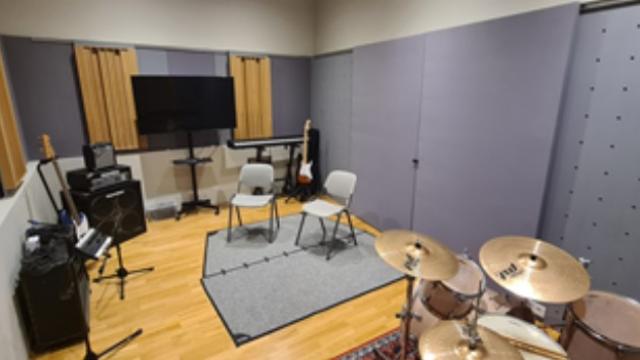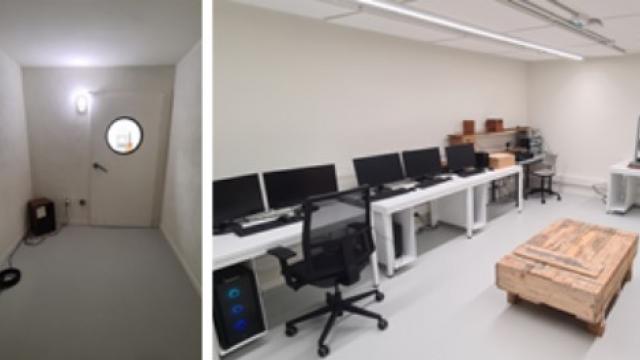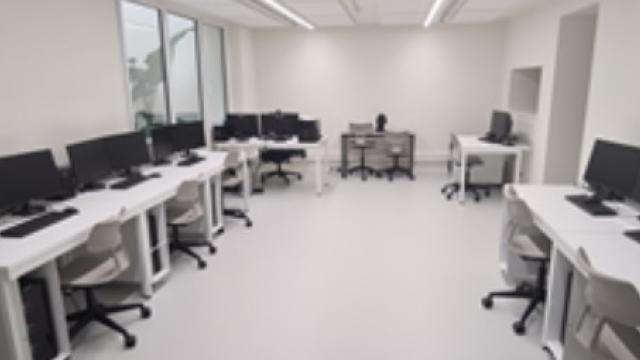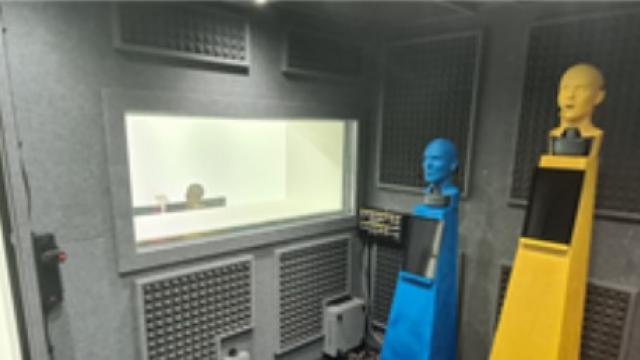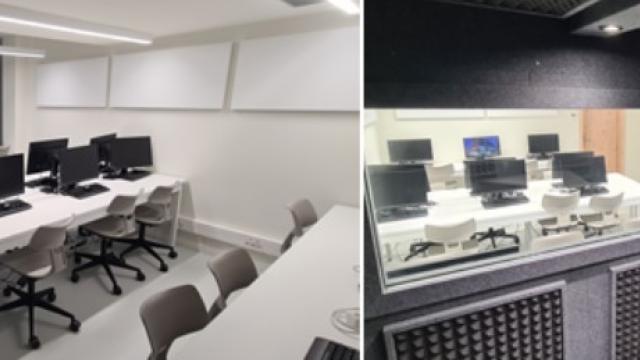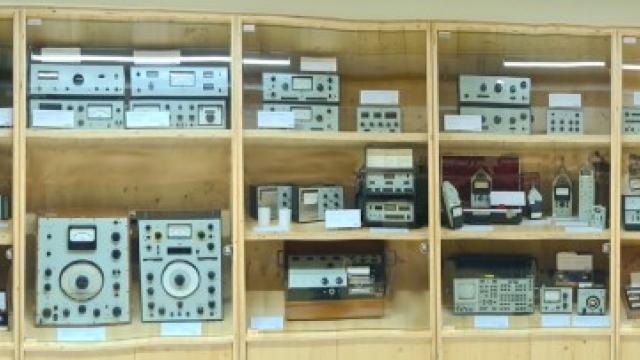The laboratory is part of the IASLab (Interactive Arts & Science Laboratory) and is located in the La Salle building on campus, with access from Carrer Sant Joan de la Salle, number 7.
Full anechoic chamber:
The anechoic chamber is a space designed so that sound waves propagate without reflecting off the walls, creating what is known as a free field. To achieve this, all surfaces—walls, ceiling, and floor—are covered with acoustically absorbent material. Light gray Basotect melamine wedges, 80 cm deep, are used and separated from the wall by a 20 cm air gap, except on the floor, where they rest on a 20 cm thick bed of absorbent material. The total volume of the chamber is 517 m³, which is reduced to 215 m³ when the absorbent material is added, leaving a clear working area of 6.1 m × 8.9 m with a height of 4.4 m. Additionally, it is well insulated from both airborne and impact noise. In the latter case, the chamber is structurally decoupled from the rest of the building using vibration-isolating elements.
Beyond its function as an anechoic chamber for acoustics, it is also semi-anechoic for the electromagnetic spectrum. One of the chamber’s walls is equipped with special wedges that absorb both sound and electromagnetic waves. The chamber is lined with copper, acting as a Faraday cage to prevent the entry of external electromagnetic waves.
This facility is primarily used to study the acoustic behavior of any sound-emitting or receiving device, such as a speaker or a microphone. It also allows sound recording in anechoic conditions thanks to its connection to the recording studio. The chamber is robotized with a Universal Robots UR5 mounted on a 2 m rail, with a measurement microphone on the robotic arm, enabling automated testing and measurements inside.
Reverberation chamber
The reverberation chamber is a room designed to create a diffuse sound field where sound arrives from all directions. All interior surfaces are covered with acoustically reflective ceramic materials, ensuring that almost all incoming acoustic energy is reflected back. The walls are arranged so they are not parallel to each other, and the ceiling has an irregular shape, which evenly distributes sound throughout the room and prevents the formation of standing waves. Diffusers hanging from the ceiling further enhance the diffusion of the acoustic field, ensuring compliance with current standards. The chamber has a total volume of 231 m³, and thanks to its features, it achieves high reverberation times across all frequencies.
The chamber is primarily used for architectural acoustics and the characterization of electroacoustic devices. It allows the measurement of the sound absorption coefficient of materials used in room conditioning and the acoustic power of sound sources.
Recording Studio
The recording studio is a facility designed for sound recording and mixing. It consists of two separate spaces: the control room and the recording room.
The control room is where the audio engineer operates during recordings and subsequent mixing. This room is acoustically treated with perforated wooden panels and absorbent materials inside to ensure that the room’s acoustic behavior is as neutral as possible. A 7.1.4 speaker system allows the engineer to produce immersive audio, as well as 5.1 and stereo monitoring, catering to the film and music industries as well as immersive audiovisual installations, such as the IASLab immersive room.
The recording room is also acoustically treated and contains various elements of variable acoustics that allow control over the room’s response, including movable diffusers and membrane and Helmholtz resonators that can be hidden behind movable panels. A double false ceiling adds absorption across the spectrum and dampens the first vibration modes. The two spaces are connected by a quadruple-glazed window. There is also an acoustic door connecting the recording room to the reverberation chamber, which can be used to introduce special reverberation effects. Additionally, the recording studio is connected to the anechoic chamber, enabling sound recordings under free-field conditions.
Resonance room
The resonance room is a space designed for experiments with the eigenfrequencies of a room. This room measures 3.45 m by 2.1 m with a height of 2.46 m, which favors the appearance of the first modes within the audible range. The first three modes occur at frequencies of 50 Hz, 70 Hz, and 81 Hz, corresponding to the first axial mode for each of the three dimensions.
In the control of the modal room, various experiments are conducted that allow for a deeper understanding not only of room vibrations but also of vibroacoustics in general. These experiments study the vibration of simple continuous mechanical systems, such as strings, bars, and plates, as well as more complex systems like a test tube formed by multiple discs connected by a bar, which makes it highly sensitive to torsional modes. The room also houses a Kundt’s tube, which allows the study of standing wave phenomena and the modal frequencies of a tube with different boundary conditions (open and closed). It also enables the measurement of the absorption coefficient of a sample under normal incidence.
Central room
The central room is the heart of the acoustics laboratory—a meeting point for researchers and students, and a space dedicated to research and the exchange of ideas. It features various computers equipped with the latest acoustic engineering software.
Computers are equipped with acoustics and audio software including programs for room simulation (Odeon, CATT-Acoustic), outdoor noise simulation (Cadna-A), acoustic insulation simulation (INSUL, AcouBAT), and finite element simulation (COMSOL). There are also programs for downloading data from sound level meters (CESVA, B&K) and multiple acoustic signal analyzers (BKConnect, Samurai, dBBati, SpectraPlus).
Additionally, there is a recording booth designed specifically for studying human voice acoustics (voice acoustics booth). This booth is intended for voice recordings and behavior analysis but is also used for acoustic experiments requiring low background noise and minimal reverberation. The booth offers excellent airborne and structural acoustic isolation as it is suspended on vibration-dampening elements and decoupled from the rest of the building. It also has effective acoustic treatment for mid and high frequencies. The booth is connected to the control room of the recording studio, enabling recordings from this space.
Audio Post-Production Room
The audio post-production room is designed for sound post-production, editing, and mixing. It includes a recording booth primarily used for voice recordings in audiovisual productions. Additionally, the room is equipped with about 10 computers, which facilitate mixing and editing of recordings made both in this room’s booth and in the recording studio. These computers also have specialized acoustic engineering software, making the room an ideal space for data post-processing.
Acoustical Instrumentation Museum
In the laboratory hallway, there are several display cases showcasing a museum with the oldest instruments available in the lab. It mainly features acoustic equipment from Brüel & Kjær from the 1970s and 1980s.

